Have you ever struggled to perfect your armbar technique in Brazilian Jiu-Jitsu? The armbar is a critical submission technique that targets the delicate elbow joint, demanding precision and control.
Whether you are grappling from the closed guard, side control, or mount, understanding the intricacies of the armbar is essential for any serious competitor.
This guide explores the variations, setups, and transitions necessary to master the armbar, offering you tools to enhance your grappling efficiency.
- Armbar History: Who Created This Technique?
- BJJ Armbar Submission: Definition & Anatomy
- Arm Bar Jiu-Jitsu Setup: How Do I Make this Submission?
- Jiu-Jitsu Armbar Variations
- Jiu Jitsu Armbar Escapes
- Brazilian Jiu-Jitsu Armbar Injury
- Armbar Submission In MMA
- Conclusion
Armbar History: Who Created This Technique?
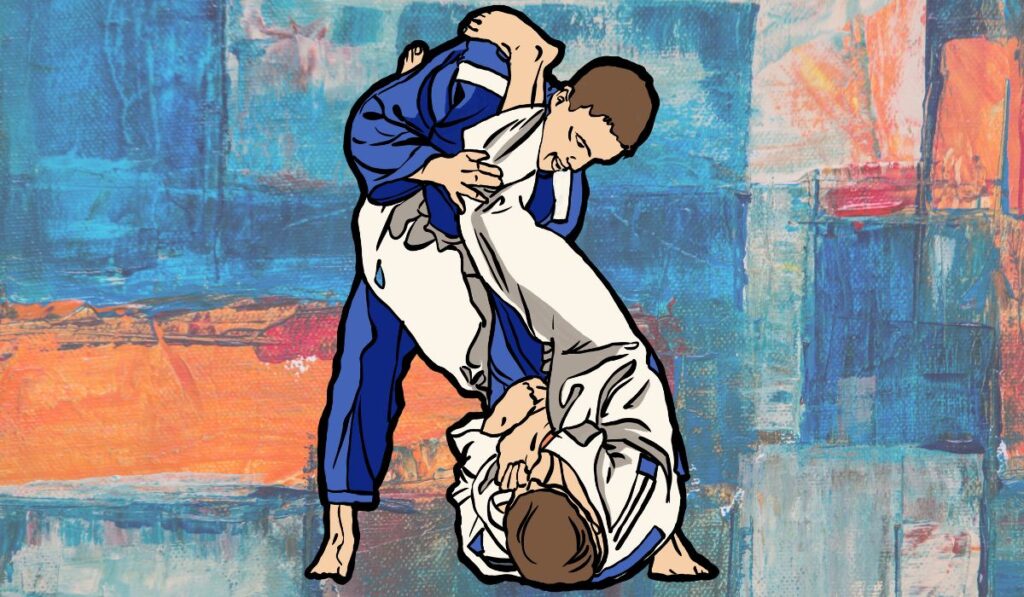
Armbars became the submission choice for Brazilian jiu-jitsu competitors like Rodolfo Viera, Alexandre Ribeiro, Andre Galvao, Marcus Almeida, and Rafa Mendes. So, you’re probably curious about who created the armbar submission.
There is no link between the BJJ armbar submission and its creator since it has existed for hundreds of years. However, this joint lock move is still used today despite nobody knowing when it was initially used.
These days, several devoted competitors and coaches have developed many jiu-jitsu armbar variation techniques. Therefore, the armbar is often used in BJJ tournaments with a high success percentage.
BJJ Armbar Submission: Definition & Anatomy
The armbar is one of the essential submission techniques available to knowledgeable practitioners in Brazilian jiu-jitsu and mixed martial arts.
It refers to the cross armlock and is most famous in Judo martial art as Ude Hishigi Juji Gatame. So, how does the arm bar work?
The armbar is a brutal lock submission that produces a hyperextension of the elbow.
In addition, it requires precise control of the opponent’s arm to be applied appropriately. In this case, the opponent will be forced to tap out due to the unsupportable pain landing on his elbow joints.
Unfortunately, this arm submission might damage your elbow if you’re late tapping out or processing the proper escape. Here is why?
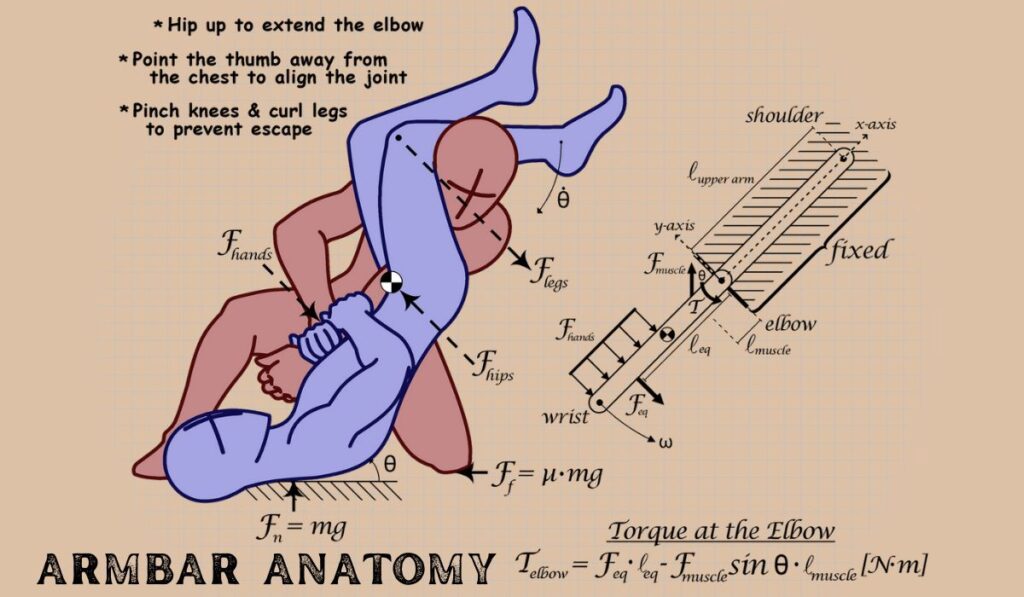
Arm Bar Jiu-Jitsu Setup: How Do I Make this Submission?

In Brazilian jiu-jitsu, the armbar technique is used in both gi and no-gi, which is a significant advantage.
A rigid arm lock is achievable a few steps after landing in a suitable position, such as the closed guard, mount, etc.
- Enter a suitable position, then control your opponent’s arm that you wish to attack. Also, don’t forget to control the opponent’s upper body (chest and head).
- Drive the controlled arm between your knees and close the distance.
- Maintain control of the opponent’s arm, and ensure his elbow lies across your hips.
- Use your full-body leverage by pulling your hips and the opponent’s wrist down. These movements extend the opponent’s elbow and force him to tap out.

N.B: The armbar steps mentioned above may differ from one BJJ position to another. So, look at the technique variations coming in the following sections.
Jiu-Jitsu Armbar Variations

The armbar is a fantastic submission with various variations you should study and practice as much as possible.
Moreover, it is achievable from multiple positions, including closed guard, spider guard, mount, side control, etc.
In other words, you can get an armbar hold practically anywhere, which is why fighters enjoy this submission.
As a result, practicing some other variations will assist you in improving your overall jiu-jitsu performance. That is why you should look at the setups that follow. Have a good time!
Armbar from Closed Guard
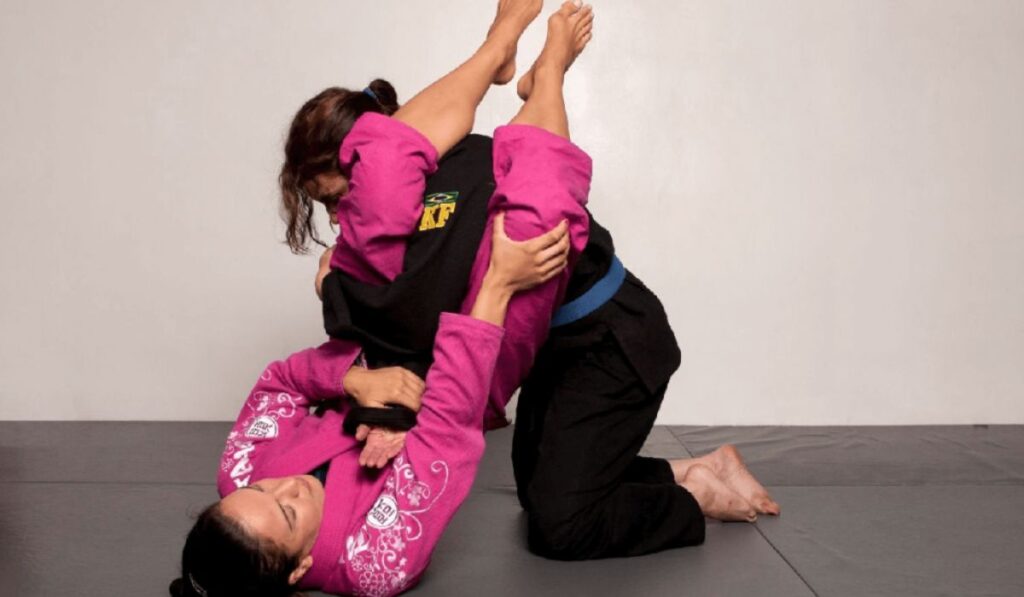
The closed guard is one of the most essential and complex guards to learn and master.
It’s a good position that allows you to perform a variety of efficient sweeps and submissions, such as the armbar, triangle choke, kimura lock, and omoplata.
In addition, the armbar from the guard position is one of the most fundamental and well-known submissions. So, you’re probably wondering how to do an armbar from the closed guard.
The following steps will help set up the closed guard armbar without problems.
- Reach the closed guard; if you’re already there, that’s nice.
- Choose one opponent’s arm to attack, then grip the wrist lightly so your opponent cannot detect your attack intent.
- Use your legs to break your opponent’s posture. Meanwhile, isolate the arm and use your free hand to control the target arm.
- Open your closed guard, then use your legs to shift your hips at a 90-degree angle within your opponent.
- Move your legs to control the opponent’s head and the others underneath his arm.
- Make sure that the attacked arm’s elbow is on your hips. And squeeze your legs to close the distance.
- Finish the closed guard by driving your hip up and the opponent’s wrist down.
Need more help!
In the following video, Giancarlo Bodoni shows you the proper steps for completing the basic armbar from a closed guard.
Armbar from Mount
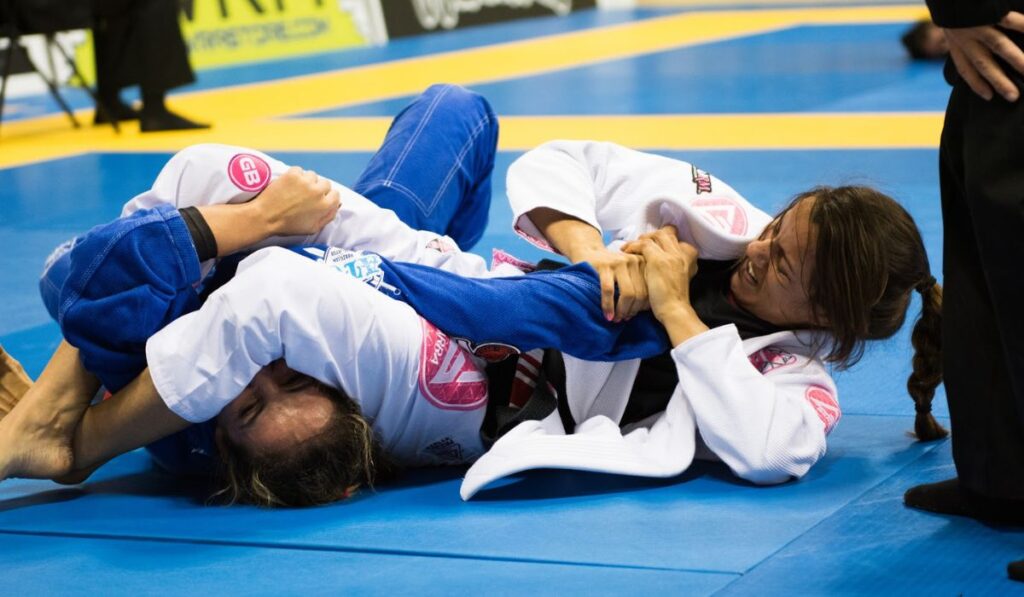
The mount is one of the most dominant positions in Brazilian jiu-jitsu.
It’s a valuable position that allows you to use various efficient submission moves, such as the armbar, triangle choke, Americana, and collar chokes.
Getting an armbar from the mount position is significantly more impressive in finishing your opponent and, consequently, the BJJ or MMA fight. So, what is the best way to accomplish the mounted armbar?
The following steps will help set up the armbar from the full mount (Juji Gatame) without problems.
- Reach the full mount and secure your position (don’t get swept).
- Climb up over your opponent’s stomach to reach the high-mount position.
- Start looking for a cross-collar choke to force your opponent to react by extending his hands. Then, frame both opponents’ hands as they come up, using your knees.
- Grab the triceps of the same side of the attacked arm.
- Pull the attacked arm into your chest and secure it by bringing your same-sided knee closer to the opponent’s head.
- Bring your chest closer to the opponent’s chest and lean your weight into their trapped arm.
- Shift your body weight to the leg most outlying from the tapped arm. Meanwhile, you should raise your other leg and around your opponent’s head.
- Drive your top leg over your opponent’s face and secure it. Then, bring your lower leg up and shift your weight to create a 90-degree angle within your opponent.
- Close the distance and make the opponent’s arm tight to your chest.
- Finnish the mounted armbar by leaning back toward the ground and raising your hips to hyperextend your opponent’s elbow.
Need more help!
In the following video, Coach John Danaher demonstrates the proper steps for completing an armbar from the mount in BJJ Gi and Nogi.
Armbar from Back Mount
The back mount, called the back control, is dominant in Brazilian jiu-jitsu and other fighting disciplines.
It’s a challenging position to outclass any adversary, even the extensive and severe fighters.
The back control can offer a variety of efficient submissions, such as the BJJ arm bar and chokes.
As a result, getting an armbar from the back mount is a significantly impressive move to finish your opponent during a fight. So, how to do the back mount armbar (rear armbar)?
Taking a glance at the following video will give you the necessary steps to complete an armbar correctly from the back control. Have fun!
Armbar from Spider Guard

The spider guard is a dynamic open guard in Brazilian jiu-jitsu. It occurs when you grip your opponent’s sleeves and have at least one foot controlling an opponent’s arm. Indeed, it allows you to off-balance on your way to some great sweeps.
In addition, the jiu-jitsu spider guard offers access to excellent and effective attacks, including the armbar, triangle choke, and other combinations to end a fight. So, how do you finish an arm bar from the spider guard position in jiu-jitsu?
The following video will give you the necessary steps to complete a spider guard armbar correctly. Have fun!
Armbar from Side Control
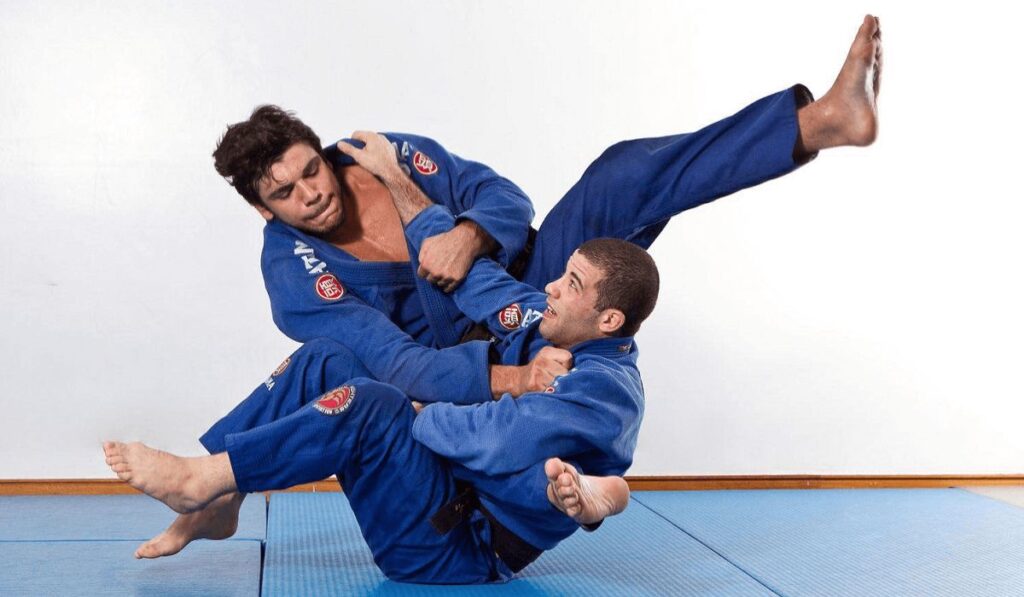
Side control is one of the best dominant positions in BJJ grappling. After passing the opponent’s guard, a persistent practitioner will land at the side control position.
When there, he will have a plethora of submissions, including armbars, chokes, etc.
The side control armbar has many variations, which will probably help you end a fight. So, what steps are needed to finish this arm joint lock from side control properly?
In the following video, Lachlan Giles teaches how to finish the far armbar from the BJJ side control.
Arm bar from Butterfly Guard

The butterfly guard is an incredibly Brazilian jiu-jitsu guard position. It’s an open guard position where the bottom player sits on the floor and controls his opponent with his shins and legs, which stand like butterflies.
Indeed, the BJJ butterfly guard is the starting point for various submission techniques, such as the guillotine choke, leg locks, kneebars, triangles, armbars, and so on.
Many fighters like Marcelo Garcia, Jean Jacques Machado, Renzo Gracie, Nino Schembri, and Leonardo Santos love this guard type.
So, what are the necessary steps to finish an armbar from the butterfly guard position?
The following video will help you understand how to finish a butterfly guard armbar properly. Have fun!
Armbar from Knee on Belly
The knee on belly is an authoritarian position in BJJ martial arts that produces unsupportable pressure on the opponent’s stomach.
Nevertheless, it’s a good position that offers you a variety of efficient submission moves, such as the rolling armbar, baseball choke, etc.
Getting an armbar from the knee on the belly is a good step toward finishing a jiu-jitsu fight. But first, how do you armbar from the knee on belly position?
The following steps will help set up an armbar from the knee on belly position correctly.
- Reach the knee belly position if you pass your opponent’s guard or from the side control.
- Force your opponent to use his hands by applying high pressure on the belly.
- Seize the opportunity to grip the opponent’s arm on the other side (preferably from the triceps). Then, pull it toward your chest while maintaining the dominant position.
- Turn by 180 degrees while controlling the attacked arm tightly.
- Use your legs to control both the opponent’s head and chest.
- Finish the submission by squeezing your legs and driving your hip up and the opponent’s wrist down.
Need more help!
The following video will teach you how to perform the armbar variation from knee-on-belly in BJJ appropriately. Have fun!
Armbar from Turtle Position
The turtle is an advanced BJJ technique that allows you to overpower your opponent. It provides access to the back mount and efficient submissions like the armbar, clock choke, d’arce choke, anaconda choke, etc.
In another context, the turtle can prevent an opponent from taking side mount and altering a guard passing, among other things.
The armbar from the turtle can effectively finish a fight. So, how to armbar correctly from the jiu-jitsu turtle position?
Taking a glance at the following steps will help perform an armbar from the turtle position.
- Enter the top turtle position; you will be there when your opponent escapes the side control or knee-on-belly positions, among other scenarios.
- Control your opponent’s hips to prevent him from escaping the turtle position.
- Move near the opponent’s upper body while maintaining pressure.
- Find your way to control your opponent’s arm, and secure it.
- Slide over your opponent’s back, and while doing so, bring one leg to hook his back and use the other knee to set aside his head.
- Adjust the position to make the controlled arm so tight. Then, extend your body to bring the opponent’s arm tight to your chest.
- Finish the turtle armbar by pulling your hips toward the ground to extend the arm’s elbow. And here is the tap.
Need more help!
The following video will provide the necessary details to complete the turtle armbar in a Brazilian jiu-jitsu fight correctly. Have fun!
Rubber Guard Armbar
The rubber guard armbar is another awesome jiu-jitsu armbar that you should try. It’s one of the most dangerous submissions in BJJ grappling and mixed martial arts (MMA).
This position necessitates being a flexible practitioner who understands how to manage his legs perfectly. Playing the rubber guard, on the other hand, is always a smart move.
Eddie Bravo’s rubber guard attack system demonstrates that he is one of the world’s most forward-thinking martial arts instructors.
On the other hand, the Rubber Guard is constantly being refined by jiu-jitsu and mixed martial arts practitioners.
Additionally, this guard variation allows you to perform many submissions, including the armbar. How do you get an armbar from the rubber guard?
Throughout the next tutorial video, you’ll discover how to do the rubber guard armbar by Eddie Bravo.
Straight Armbars
The straight armbar is one of the best submissions in Brazilian jiu-jitsu and other martial arts. It’s a fantastic submission in which you hyperextended the opponent’s elbow using your hands rather than your hips.
Otherwise, the straight armbar is achievable from many BJJ positions, including the mount, side control, etc. Therefore, how can it be done from the full guard?
The straight armbar from the guard is likewise the regular guard armbar, except you will attack the arm on the same side, not the cross.
So, glance at the following steps to complete a straight armbar from the full guard correctly.
- Reach the full guard position.
- Use both arms to control one opponent’s arm, wrist, and elbow.
- Break your opponent’s posture.
- Make a shrimp move to move your hips near the opponent’s side of the controlled arm.
- Isolate the opponent’s arm properly while you’re securing the control.
- Move your top leg across the opponent’s back, where the knee will crack down on the nearside shoulder of your opponent. Your lower leg must have a foot on the opponent’s far-side hip.
- Squeeze your knees together.
- Bring the opponent’s arm and wrist up, then secure it between your shoulder and neck.
- Move your arms up to land on the opponent’s elbow and clasp them together using a gable grip.
- Finish the straight armbar by driving your arms to hyperextend the opponent’s elbow and force him to tap out.
Need more help!
The following video will give precise details on doing the straight armbar from the full guard.
Flying Armbar
The flying armbar move stands among the foremost spectacular submission techniques in mixed martial arts and Brazilian Jiu-Jitsu.
It’s a quick, savage, and effective submission when performed correctly.
But, If you cannot do it properly, you will cause an undesirable injury. So, be prudent when you make these acrobatic moves. So, how to perform a flying armbar correctly?
Looking at the following steps will help adequately set up a flying armbar from the standing position.
- Make sure you’re winning the hand fighting and distance managing while standing.
- Be the fighter who ties his opponent up, one arm around the head, the 2nd overwrapping his arm.
- Use the action-reaction principle to cause an explosive opponent’s reaction. For example, you can snap down your opponent’s neck to cause a reaction.
- While your opponent tends to regain balance, you must bring your foot and jump with one leg over the controlled arm toward the opponent’s face.
- Keep the controlled arm’s wrist tight to your chest and slide it down.
- Finish the jiu-jitsu standing flying armlock by driving your hips up to create a hyperextension of the opponent’s elbow.
Helicopter Armbar
The helicopter armbar movement is among BJJ martial arts’s most impressive submission techniques.
It is a rapid, brutal, spectacular armlock submission that, when executed correctly, may be very effective.
Now, you may wonder who the first fighter to try the helicopter armbar was.
Braulio Estima, Gracie Barra’s black belt, was the first BJJ fighter to try the helicopter armbar.
Like the other submissions, the helicopter armbar requires robust control over your jiu-jitsu adversary. So, how can you finish this technique accurately?
There are several ways to access the helicopter armbar, including the open guard or De La Riva guard. Here are the steps to properly set up the armbar from the DLR guard position.
- Reach the DLR guard position and secure the position.
- Load the opponent’s weight over you until he’s floating over you. But make sure that your hips are underneath your opponent.
- Rock backward, roll your opponent’s weight onto your feet, and lift them.
- While the opponent’s weight loads above you, unhook your De La Riva hook, pull the controlling arm towards you, and convey the unhooked foot around your opponent’s head.
- Simultaneously, tap the opposite foot on the opponent’s hip to make a rotation.
- Your opponent should fall under the armbar position if all is done correctly.
- Finish the helicopter armbar.
Need more help!
The following video will give the necessary details to complete the helicopter armbar appropriately in a Brazilian jiu-jitsu fight.
Reverse Armbar
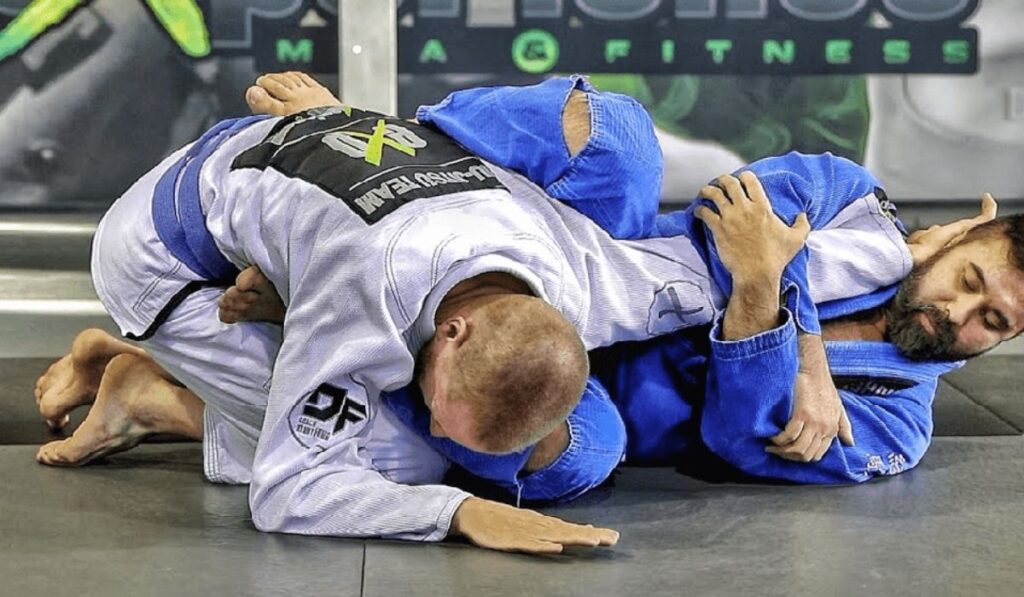
The reverse armbar is among those sneaky and effective variations you should know.
Numerous entrances to this powerful jiu-jitsu submission exist, including the closed and butterfly guards.
Otherwise, the reverse armbar can be extremely useful in certain situations, such as getting cool sweeps or transitioning to other positions.
One reason so many fighters enjoy these techniques is that they are practical and provide them with many options.
You’ve come to the right place if you’re wondering how to do the reverse armbar.
The following are two fantastic reverse armbar variations you should try to learn.
Reverse armbar from guard
Throughout the above video, you’ll get more information on how to do the reverse armbar from the closed and butterfly guard. Source: Stephan Kesting
Reverse armbar from mount
Inverted Armbar
The inverted armbar is another fantastic variation that can help you improve your BJJ attack system if you are already proficient.
However, it is one of the armbar variations many fighters in BJJ tournaments underappreciate.
No-gi grapplers primarily use the technique, and it is most often entered from the closed guard.
As a result, a beginner Jiu-Jitsu practitioner will undoubtedly enjoy learning and applying this effective armbar variation.
If you want to learn more about the reverse armbar, you’ve come to the right place.
In the following video, Fabio Gurgel teaches you how to perform an inverted armbar from the guard.
Jiu Jitsu Armbar Escapes
Countering a submission, like the armbar, can be a significant step toward gaining an advantage over your opponent and maybe winning the fight.
However, a successful escaping process depends on numerous elements, including the ability to implement the right moves at the right time.
Here are some helpful armbar escapes you should learn to improve your BJJ game.
Armbar Escape from the Guard
Armbar Escape from Mount
Armbar Escapes By Stephan Kesting
Armbar Escapes By Andre Galvao
Brazilian Jiu-Jitsu Armbar Injury
The armbar submission provokes an elbow’s hyperextension, which can cause massive elbow pain.
“Hyperextended elbows occur when the elbow joint moves outside its normal range of motion. The injury can be painful and can take several weeks to heal.” According to Medical News Today
So, you’re probably wondering how to heal your elbow after armbar.
In the following video, you’ll learn fantastic tips for reducing pain and healing your elbow after a severe armbar submission.
Recommended: Most takedowns are brutal, putting a lot of strain on the knees. As a result, practitioners must carry reliable knee pads to protect their joints and avoid injury. Click here to learn more!
Armbar Submission In MMA
Armbars are among the most compelling submissions in mixed martial arts. Many MMA fighters, including Ronda Rousey, have proven their efficiency with armbar moves.
Enjoy these five fantastic armbar MMA submissions in ONE Championship
Conclusion
The armbar is a key submission move in martial arts. It uses control of the opponent’s arm to hyperextend the elbow joint. It can be executed from many positions and has several variations.
The best armbar variations include the closed guard armbar, mounted armbar, side control armbar, and straight armbar.
Mastering these techniques can improve your performance in Brazilian jiu-jitsu and help you win more matches.
Related: The triangle choke is one of the most excellent attacks you should add to your BJJ arsenal. This firm chokehold is a must-know for any serious practitioner. Click here to learn more!


